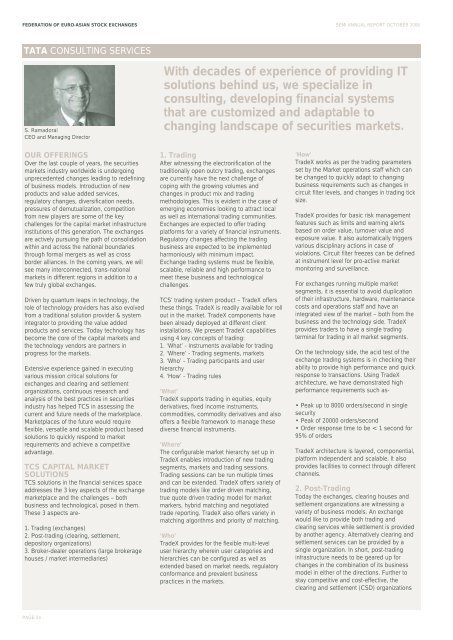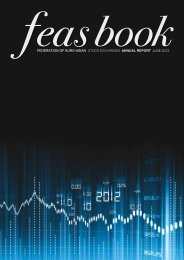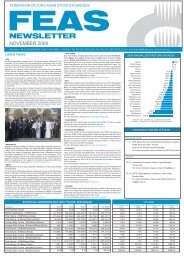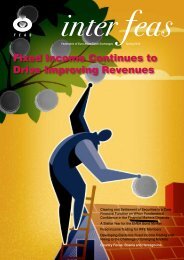Download - FEAS
Download - FEAS
Download - FEAS
You also want an ePaper? Increase the reach of your titles
YUMPU automatically turns print PDFs into web optimized ePapers that Google loves.
FEDERATION OF EURO-ASIAN STOCK EXCHANGES SEMI ANNUAL REPORT OCTOBER 2006<br />
TATA CONSULTING SERVICES<br />
S. Ramadorai<br />
CEO and Managing Director<br />
With decades of experience of providing IT<br />
solutions behind us, we specialize in<br />
consulting, developing financial systems<br />
that are customized and adaptable to<br />
changing landscape of securities markets.<br />
OUR OFFERINGS<br />
Over the last couple of years, the securities<br />
markets industry worldwide is undergoing<br />
unprecedented changes leading to redefining<br />
of business models. Introduction of new<br />
products and value added services,<br />
regulatory changes, diversification needs,<br />
pressures of demutualization, competition<br />
from new players are some of the key<br />
challenges for the capital market infrastructure<br />
institutions of this generation. The exchanges<br />
are actively pursuing the path of consolidation<br />
within and across the national boundaries<br />
through formal mergers as well as cross<br />
border alliances. In the coming years, we will<br />
see many interconnected, trans-national<br />
markets in different regions in addition to a<br />
few truly global exchanges.<br />
Driven by quantum leaps in technology, the<br />
role of technology providers has also evolved<br />
from a traditional solution provider & system<br />
integrator to providing the value added<br />
products and services. Today technology has<br />
become the core of the capital markets and<br />
the technology vendors are partners in<br />
progress for the markets.<br />
Extensive experience gained in executing<br />
various mission critical solutions for<br />
exchanges and clearing and settlement<br />
organizations, continuous research and<br />
analysis of the best practices in securities<br />
industry has helped TCS in assessing the<br />
current and future needs of the marketplace.<br />
Marketplaces of the future would require<br />
flexible, versatile and scalable product based<br />
solutions to quickly respond to market<br />
requirements and achieve a competitive<br />
advantage.<br />
TCS CAPITAL MARKET<br />
SOLUTIONS<br />
TCS solutions in the financial services space<br />
addresses the 3 key aspects of the exchange<br />
marketplace and the challenges – both<br />
business and technological, posed in them.<br />
These 3 aspects are-<br />
1. Trading (exchanges)<br />
2. Post-trading (clearing, settlement,<br />
depository organizations)<br />
3. Broker-dealer operations (large brokerage<br />
houses / market intermediaries)<br />
1. Trading<br />
After witnessing the electronification of the<br />
traditionally open outcry trading, exchanges<br />
are currently have the next challenge of<br />
coping with the growing volumes and<br />
changes in product mix and trading<br />
methodologies. This is evident in the case of<br />
emerging economies looking to attract local<br />
as well as international trading communities.<br />
Exchanges are expected to offer trading<br />
platforms for a variety of financial instruments.<br />
Regulatory changes affecting the trading<br />
business are expected to be implemented<br />
harmoniously with minimum impact.<br />
Exchange trading systems must be flexible,<br />
scalable, reliable and high performance to<br />
meet these business and technological<br />
challenges.<br />
TCS’ trading system product – TradeX offers<br />
these things. TradeX is readily available for roll<br />
out in the market. TradeX components have<br />
been already deployed at different client<br />
installations. We present TradeX capabilities<br />
using 4 key concepts of trading:<br />
1. ‘What’ - Instruments available for trading<br />
2. ‘Where’ - Trading segments, markets<br />
3. ‘Who’ - Trading participants and user<br />
hierarchy<br />
4. ‘How’ - Trading rules<br />
‘What’<br />
TradeX supports trading in equities, equity<br />
derivatives, fixed income instruments,<br />
commodities, commodity derivatives and also<br />
offers a flexible framework to manage these<br />
diverse financial instruments.<br />
‘Where’<br />
The configurable market hierarchy set up in<br />
TradeX enables introduction of new trading<br />
segments, markets and trading sessions.<br />
Trading sessions can be run multiple times<br />
and can be extended. TradeX offers variety of<br />
trading models like order driven matching,<br />
true quote driven trading model for market<br />
markers, hybrid matching and negotiated<br />
trade reporting. TradeX also offers variety in<br />
matching algorithms and priority of matching.<br />
‘Who’<br />
TradeX provides for the flexible multi-level<br />
user hierarchy wherein user categories and<br />
hierarchies can be configured as well as<br />
extended based on market needs, regulatory<br />
conformance and prevalent business<br />
practices in the markets.<br />
‘How’<br />
TradeX works as per the trading parameters<br />
set by the Market operations staff which can<br />
be changed to quickly adapt to changing<br />
business requirements such as changes in<br />
circuit filter levels, and changes in trading tick<br />
size.<br />
TradeX provides for basic risk management<br />
features such as limits and warning alerts<br />
based on order value, turnover value and<br />
exposure value. It also automatically triggers<br />
various disciplinary actions in case of<br />
violations. Circuit filter freezes can be defined<br />
at instrument level for pro-active market<br />
monitoring and surveillance.<br />
For exchanges running multiple market<br />
segments, it is essential to avoid duplication<br />
of their infrastructure, hardware, maintenance<br />
costs and operations staff and have an<br />
integrated view of the market – both from the<br />
business and the technology side. TradeX<br />
provides traders to have a single trading<br />
terminal for trading in all market segments.<br />
On the technology side, the acid test of the<br />
exchange trading systems is in checking their<br />
ability to provide high performance and quick<br />
response to transactions. Using TradeX<br />
architecture, we have demonstrated high<br />
performance requirements such as-<br />
• Peak up to 8000 orders/second in single<br />
security<br />
• Peak of 20000 orders/second<br />
• Order response time to be < 1 second for<br />
95% of orders<br />
TradeX architecture is layered, componential,<br />
platform independent and scalable. It also<br />
provides facilities to connect through different<br />
channels.<br />
2. Post-Trading<br />
Today the exchanges, clearing houses and<br />
settlement organizations are witnessing a<br />
variety of business models. An exchange<br />
would like to provide both trading and<br />
clearing services while settlement is provided<br />
by another agency. Alternatively clearing and<br />
settlement services can be provided by a<br />
single organization. In short, post-trading<br />
infrastructure needs to be geared up for<br />
changes in the combination of its business<br />
model in either of the directions. Further to<br />
stay competitive and cost-effective, the<br />
clearing and settlement (CSD) organizations<br />
PAGE 24
















